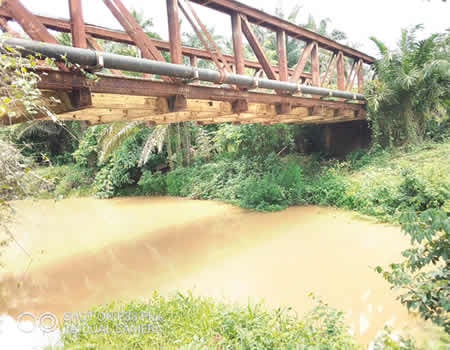JALUMI WAR: THE HISTORICAL SIGNIFICANCE OF OTIN RIVER IN INISA
Whether a visitor is entering Inisa in Osun State from Kwara State or Osogbo, Osun state, accessing River Otin, from which the local government council name is conspicuous, and commercial motorcycle operators are stationed at the entrance of the town on the highway, always ready to guide visitors’ movement.
Within five minutes on a road leading to the Inisa Railway Station, a visitor on a motorcycle ride the motorcycle is already on a colonial bridge sitting firmly on the body of brownish water: River Otin, a serene enclave laying in forestland.

Nigerian Tribune gathered that the road to the site was constructed in the colonial era to purposely service users of the railway station located less than a kilometre to the river.
The administration of Governor Olagunsoye Oyinlola in Osun State between 2003 and 2010 was said to have attempted to give River Otin the facelift it required as a tourist site of historical significance. However, the project had not left the drawing board when the administration was terminated about six months to its official expiry date. The succeeding Ogbeni Rauf Aregbesola administration of the then Action Congress of Nigeria (ACN) allegedly turned a blind eye to the project, leaving the site which could have generated revenue to the government in the same state of total neglect.
Apart from a monument said to have been erected in 2018 by the Inisa community, River-Otin can pass for any other stream running through the landscape of Yorubaland. There is no other physical mark which supports its history as the river where many Fulani combatants perished during the 1878 war which would derive its name from the incident that occurred in the river.
It was learnt that the Fulanis were strongly determined, and made a vow to occupy the entire Yoruba nation, having successfully subjugated Ilorin and some parts of what is today Kwara State. The Ibadan army saw the Fulanis’ ambition as an affront which must be confronted, and mobilised soldiers who prosecuted that battle. But there was a paradox.
According to The History of the Yorubas: From the Earliest Times to the Beginning of the British Protectorate by Samuel Johnson, the Ekitis, Ijesas and Ilas struck an alliance with the Ilorin army and engaged the Ibadan army, which they considered to be too domineering and pursuing imperialist agenda in Yorubaland. That alliance accounted for the Jalumi War or Battle of Ikirun which witnessed large volume of blood lost on both sides. The battle ground was Ikirun in present Osun State where the Ibadan army, led by Balogun Ajayi Ogboriefon, met the allied army and slugged it out with them.
It was also gathered that “Ogboriefon successfully defeated the Ilorins and drove them out of their camp, but he was too late; Osi Ilori had already been killed. He completed the victory by defeating the Ilas and Ekitis. Ibadan soldiers chased the Ilorin survivors to Inisa, a town between Ofa and Ikirun. When news reached the people of Ofa that the Ilorins were retreating towards Inisa, they cut the bridge across the Otin River in the rear and left the retreating Fulanis of Ilorin devastated.”
“The Fulanis were pushed into the river by the Ibadans and drowned en masse; thus the war was named Jalumi which literally means ‘drown in the river’. Hence the 1878 Battle of Ikirun was also called Battle of waterloo. After the war, Ibadan armies were stationed in Ikirun, but left after an agreement between Ikirun and Ibadan. This birthed the statement “Kí ogun ó tó kúrò ní Ìkìrun, ọ̀rọ̀ ló tẹ́lẹ̀” which means “Before warriors left Ikirun, there were some discussions/agreement.”
That war literally catapulted Inisa to prominence among Yoruba towns and communities as established further by the Olunisa of Inisa, Oba Joseph Fasikun who ascended the throne in May 1978. The traditional ruler, who studied History at the then University of Ife, now Obafemi Awolowo University, offered more insight into the Jalumi War as regards strategic role which indigenes of Inisa played in the war.
In a solemn tone, Oba Fasikun remarked that the people of Inisa suffered untold hardship during the war, losing lives and property. He said many ended in the camp of Ibadan in Ikirun but became instrumental to the end of the war. He added that Inisa soldiers understood the geography of their area, a knowledge which they put into effective use to guide the Ibadan army against the allied armies.
“In this circumstance, you should know that Inisa soldiers would naturally have advantage over others even including the Ibadan army which they were supporting in the war. They were led by Ogungbesan Akande of Subokun family and broke the wooden bridge over River Otin, an action which caused the final doom of the Ilorin army.”
“The same Ogungbesan reported to Balogun Ajayi Ogboriefon, the commander of Ibadan army. Some of Inisa great warriors during the internecine conflicts included the Balogun of Inisa, Chief Farai Oyedele of Ayelegun family; Awobode, Ogunsami and Ogungbesan’s three brothers of Subokun family and Akinbode of Erorinno compound,” he said.

Oba Fasikun noted that the fallout of Fulanis’ defeat was their desire to avenge the Fulani siege on Offa and neighbouring Ibolo towns and villages between Offa and Osogbo for many years, though they (Fulani) but failed to dislodge Offa because, according to him, Offa was a warrior town supported by the Ibadan army.
“Inisa sent her contingent in support of Ofa. Oba Otepola I led the contingent but that war cost him his throne. How did it happen for an Oba in battlefield to lose his throne? There was shortage of food and ammunition in the Inisa camp and some of the soldiers in the camp were sent home for reinforcement of supply.
“The group was led by Akinbode of Erorinmo compound. But some members of Oba Otepola’s family thought the soldiers in town were cowards who had escaped. So they went after them in their home and attacked them. That news reached the warfront and led to a reprisal attack which resulted in the rejection and dethronement of Oba Otepola. The Kabiyesi had to leave the camp and went on exile to Ikirun where he remained till the end of his life. Oba Binuyo was installed,” Oba Fasikun recalled.
With the historical details, the Olunisa concluded that it was high time River Otin was accorded due recognition as an important site expected to attract traffic of tourists from Nigeria and across the Atlantic. He said his community had shown commitment with the erection of the water cannon monument at the bank of the river. He declared that the strength of his people lies in their communal efforts as evident in the role they played in the Jalumi War, saying despite the fact that they were not trained warriors, they volunteered and went to war with a mindset to protect Inisa.
“The history is there as reference to the nature of the Inisa people. We came together and built that cannon monument because it is the site where Captain R. Bower, the first resident and travelling commissioner of the interior Yoruba camped. The gallantry of Inisa people in combating the menace of the Fulani was recognised by the colonial military officers representing Lagos administration in the interior of Yorubaland. The site was strategic,” he said.
An octogenarian, Pa Mustafa Salmon, whose residence was close to the river, gave kudos to Oba Fasikun following the construction of the Captain Bower monument, and called on the government to consolidate on it to make the site more attractive to tourists. He said students of History would find the place attractive to understand the subject better.
“This water should serve more purpose than being used for domestic use. We use the river at all seasons, but it is should serve a better purpose. You can see that the road you took here is bad. Government should come and construct better road to make visits easy,” he said.
@ TUNDE BUSARI @ Nigerian Tribune


